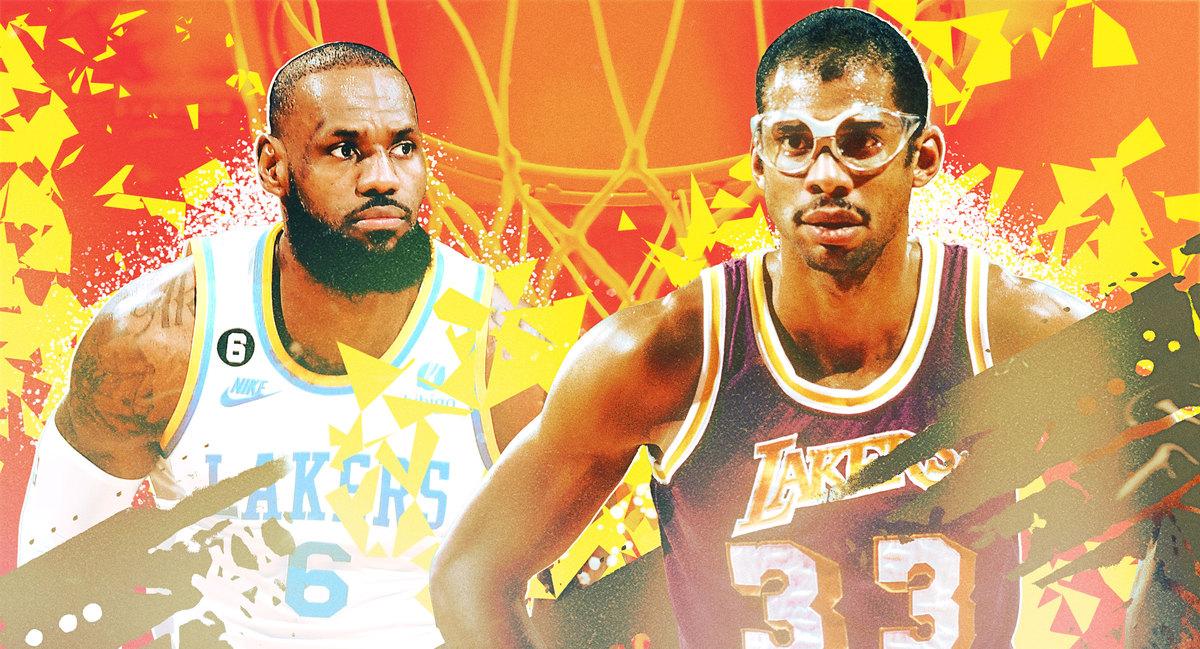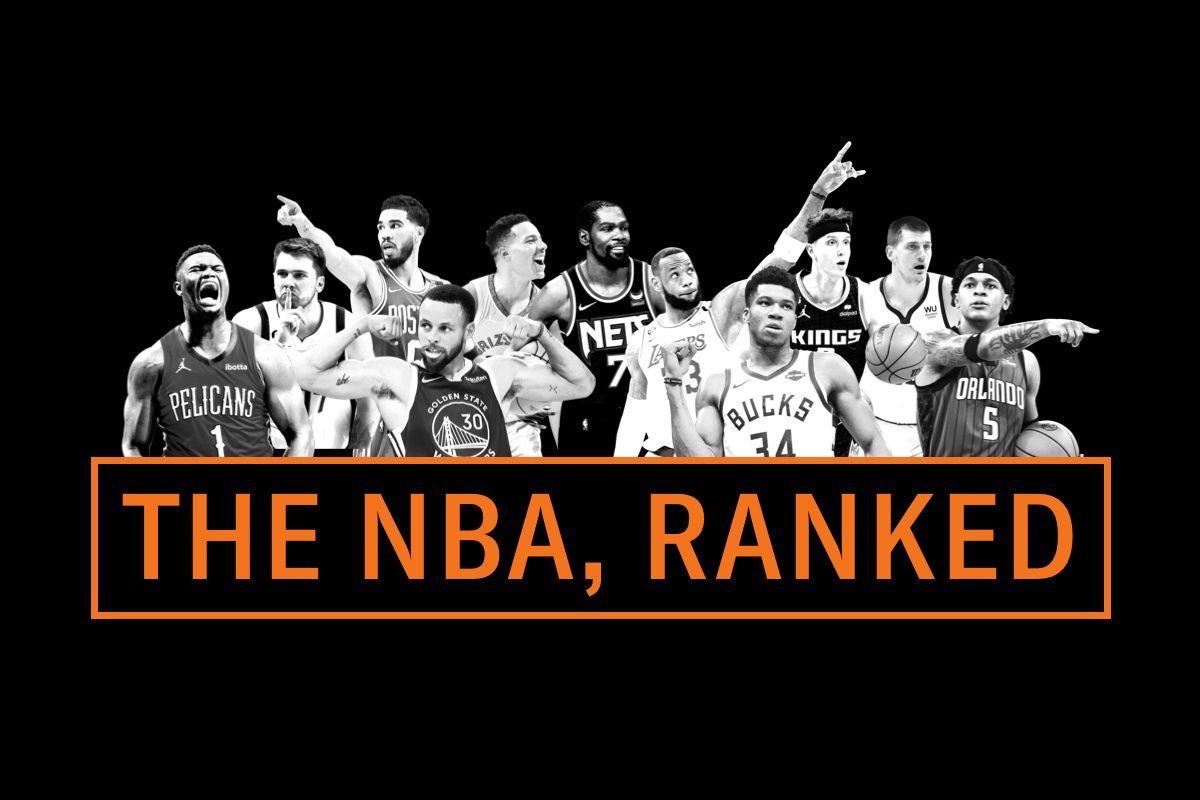LeBron, Kareem, and the Secrets to Greatness
How did two of the game’s greatest scorers stay dominant for so long? We spoke with players and coaches who observed LeBron James and Kareem Abdul-Jabbar up close and had a behind-the-scenes look at their similarities.The rookie needed a nickname. It was the summer of 2003, during LeBron James’s first week of workouts as an NBA player, when one of his Cleveland Cavaliers assistant coaches, Bob Donewald Jr., insisted they come up with one.
Of course, James didn’t need a nickname. Everyone already knew who he was and how good he could become. The generational talent had jumped to the league straight out of high school at 18 years old with a $90 million Nike endorsement contract in one hand and astronomical expectations in the other.
“Well, my nickname’s the King,” Donewald remembers LeBron saying.
“I can’t call you the King. Fuck that.”
“Why not?”
“Well, Elvis Presley was the King.”
James smiled. “Maybe I’m Elvis reincarnated.”
“All right, dude,” Donewald said. “Elvis it is.”
The veteran Cavaliers players started calling him Elvis. The rest of the team and staff soon followed. And though Elvis still had to carry his teammates’ bags, a typical duty for a rook, there was something undeniable about his maturity, poise, and work ethic. It was how early he showed up to practice. It was how hard he trained, going game speed with every rep. He worked out six days a week. He biked 25-30 miles most days. Whenever he spotted a weakness in his game, he’d tell his coaches, “We need to study that.”
“People say, ‘He’s talented.’ They have no idea, no clue, the number of hours that man put in the gym,” says Donewald, now an assistant coach at the University of Texas. “Elvis worked. He worked like no other.”
Once, Donewald was getting on James, chewing him out for something. Maybe his shot falling short. Afterward, Donewald asked James how he felt he performed that day.
“Not great. My legs were a little heavy,” he remembers James saying, before the rookie quickly added: “Not an excuse.”
“The good thing,” Donewald said, “is when I got on you, you kept fighting through it.”
“Coach, you’re not going to have a problem with me. You can coach me. That will never be an issue.”
“That’s good, because I want you to be great.”
James paused, his lighthearted stare slowly dissolving into a scowl.
“I am fucking great,” James said. “Now if you want me to be the greatest? That’s my goal. To be the greatest.”
Twenty years later, James is on the cusp of bridging the gap between who he thought himself to be and who he has strived to become. Entering Tuesday night’s game, he’s just 36 points shy of passing Kareem Abdul-Jabbar for the NBA’s all-time scoring record. Abdul-Jabbar (38,387 points) had set the previous mark on April 5, 1984, surpassing Wilt Chamberlain.
The prospect of James eclipsing this milestone is a breathtaking moment to behold, one that begs us to reflect on what it took for his body, mind, and spirit to perform at that high a level for so long. James, who is averaging 30 points a game this season at 38 years old, pushed himself all these years not necessarily to meet others’ expectations but to meet his own. He never stopped working, adding to his skill set year after year.
Many will compare James to Abdul-Jabbar, debating who was better, who would dominate in each other’s era, and who truly is the greatest of all time and poring over their differences, which are vast: Abdul-Jabbar is considered the greatest college player of all time, while James didn’t attend college. Abdul-Jabbar was strictly a center, while James plays all five positions. Abdul-Jabbar, who started his pro career in Milwaukee in 1969, won six titles; James, who also played for the Cavaliers and the Heat, has won four. The 3-point line didn’t exist for much of Abdul-Jabbar’s heyday, and neither did the sprawling number of medical advancements and training resources that James and his generation now have unfettered access to.
But what if we looked at what makes these two phenomenal athletes similar? What exists within each of them that allowed them to reach such a milestone? One crucial overlap is their lifelong passion for learning. They were true students of the game. They never gave in to the hype; they always thought they could get better. They listened. They studied. They were never too big-time, or too old, to learn something new. They realized their bodies would age but they could always sharpen their minds, evolving their skill sets as the seasons passed. As dominant and self-assured as they were, they retained a certain humility, one that ultimately aided their longevity.
Bill Bertka saw that up close. The 95-year-old former Lakers assistant coach, who has been a part of 10 championships with the organization, is now a basketball consultant for the team. He’s one of the few evaluators who had a front-row seat to both players’ ascensions. Bertka started as a scout, became an assistant coach with the Lakers from 1968 to 1974, and then came back as an assistant from 1981 to 2001, before taking over as director of scouting until 2012.
He saw how serious Abdul-Jabbar was about his craft. His concentration was evident as soon as he arrived at the Lakers locker room. “People took that sometimes as an affront, but it was because he was so focused,” Bertka says.
The more Bertka coached Abdul-Jabbar, the more he observed not just the center’s competitiveness but his curiosity. His willingness to be coached. One practice, Bertka pulled Abdul-Jabbar aside: “I want you to read the scouting report that people put out on you.” Bertka explained that teams knew to double-team him when he set up on the left side of the basket, straddling his left leg and preventing him from taking the step he needed to execute his signature skyhook as easily as he did on the right side, his sweet spot. As a result, sometimes Abdul-Jabbar was forced to settle for jumpers or tough fadeaways.
“We’re going to work on a couple of countermoves on the left block,” Bertka said. By this point, Abdul-Jabbar had already won two championships—one with Milwaukee in 1971 and one with L.A. in ’80, and had been named NBA MVP six times. But instead of tuning out his coach, or giving lip, Abdul-Jabbar got to work on countermoves in case of the double-team: a power-move baseline and a drop-step move.
“I’m working with the greatest player in the game. He’s 35 years old and he listened and made those adjustments,” Bertka says. “That’s pretty damn impressive when you hold all the records, you’ve dominated the game, and you’re willing to work on new skills.”
Bertka sees that same drive in James. He sees how badly James wants to win. And though he sees natural similarities between the two men—“They’re both extremely intelligent and both very dedicated”—he pauses before describing James individually.
“God only made one of his model.”
Even though Abdul-Jabbar and James do not reportedly have any kind of personal relationship, James has benefited from the blueprint Abdul-Jabbar had set before him, going all the way back to James’s early days with the Cavs.
Toward the end of one of those workouts with the Cavs, Donewald asked James: “Do you ever work on Kareem’s skyhook?”
James didn’t really have an answer.
“Try it,” Donewald said. “You can get to that spot. Magic used it as a big guard. He went in there.”
James took the ball down the middle of the floor, planted one foot, and slowly rose higher, hooking the ball in one fluid scoop over an imaginary defender.
Swish.
Over the last few weeks, as James has inched closer to surpassing Abdul-Jabbar’s record, commentators have speculated about when and where it might happen. There was a similar feeling of inevitability when Abdul-Jabbar was approaching Chamberlain’s mark in 1984.
“It was taken for granted that it was going to happen,” says Josh Rosenfeld, the Lakers’ director of public relations from 1982 to ’89. Rosenfeld received so many phone calls about the game at which Abdul-Jabbar was expected to reach the milestone that the Las Vegas hotel where he was staying sent security up to his room to make sure nothing suspicious was happening.
Thomas Bonk, who covered the Lakers for the Los Angeles Times, remembers calling Chamberlain for comment for his preview story the day before the big game. “Wilt was pissed off at Kareem,” Bonk says. “Not because he was breaking the record,” Bonk explains, but because Chamberlain felt Abdul-Jabbar should be more aggressive on the boards.
“How many rebounds did he average, my man?” Bonk recalls Chamberlain asking.
“I don’t know. Eight? Nine?” Bonk said. (It was 7.4.)
“He should be averaging 20.”
The next day, Bonk told Abdul-Jabbar what Chamberlain had said, seeking comment. “[Kareem] didn’t like hearing that stuff,” Bonk says. He just competed as hard as he always did. Still, his miraculous achievement later that night wasn’t necessarily considered as big of a deal at the time as it would be in today’s social-media era.
The NBA was in a different place then. Games were still on tape delay. Magic and Larry Bird had arrived only about five years earlier. Bonk remembers David Stern attending Abdul-Jabbar’s record-breaking game and sitting by himself. “[The NBA] was still kind of a little traveling circus,” Bonk says.
Bertka remembers a time-out called in the fourth quarter right before the big moment: “We knew that the next basket was going to set the record, and Magic said to everybody, ‘Just make sure that I’ve got the ball and make the pass.’”
Sure enough, with just under nine minutes left in regulation, teammates gave the ball to Magic, who dribbled to the right side of the floor before throwing in a pass to Abdul-Jabbar. The center escaped the double-team by spinning baseline for his record-beating skyhook. His teammates hugged him, and fans celebrated the achievement.
After becoming the NBA’s all-time leading scorer, Abdul-Jabbar didn’t stop working at his game. He had been that way since the start of his pro career in Milwaukee in 1969. “I never saw anybody more prepared,” says Eddie Doucette, the Bucks broadcaster who had been with the team since its inception in 1968 until 1984. Doucette coined the term “skyhook.” “I never saw anybody that was more a student of what he had to do in a quiet way,” Doucette says. “He didn’t go out of his way to make people know that he was doing this or doing that.”
Kareem was meticulous in his attention to detail, studying the tendencies of his opponents and their defenses. Former Bucks teammate Jon McGlocklin, who was a member of the 1971 championship squad and later served as the Bucks color analyst from 1976 to 2018, remembers Abdul-Jabbar telling him about facing Nate Thurmond early on in their time together in Milwaukee.
“He told me that Thurmond played him better and tougher than anybody else in the NBA,” McGlocklin says. Abdul-Jabbar then explained to McGlocklin that he had been studying the way Thurmond defended him, realizing he had to become more physical in establishing position, and could feel himself improving each time he faced him.
McGlocklin and Abdul-Jabbar were in different places in their careers: McGlocklin says he was just trying to hold on to his job; Abdul-Jabbar was a superstar. But when Bucks coach Larry Costello gave his players a written test on the team’s whopping 83 plays, Abdul-Jabbar followed orders like everyone else. “[He] didn’t go, ‘Screw you, Larry,’” McGlocklin says.
Abdul-Jabbar could have been considered a finished product the second he arrived in the league, but he never carried himself as if he were infallible or above anyone else. When he joined the Lakers, he would always look coach Pat Riley in the eye during time-outs. He was an early appreciator of analytics, as the Lakers staff came up with a formula for grading a player’s performance in each game based on stats, even logging rebound attempts. Abdul-Jabbar really took to the system. He was interested in consistency: Did he maintain his level of play or was there a drop-off? “Pat wouldn’t compare what Kareem did with what Magic did, or what [James] Worthy did,” Rosenfeld says. “But he would compare Kareem with his career and his career numbers.”
Abdul-Jabbar played until he was 42.
But his intellectualism and his competitiveness kept driving him even after he retired in 1989. The next season, he showed up to Lakers training camp as a sort-of coach to tutor a Serbian rookie center named Vlade Divac.
Abdul-Jabbar taught him footwork, and the two labored for hours on moves. Abdul-Jabbar could have just gone through the motions and played dummy defense. But he didn’t, especially as the rookie attempted the skyhook over him. “He would block every single shot. It was unbelievable,” Divac says.
Abdul-Jabbar wasn’t willing to take a night off, even after his playing days had ended.
James would operate with the same kind of urgency. When Jeff Green joined the Cavaliers in July 2017, the first thing he did was find James’s number and text him: “Bro, when you come here, I want to be with you every day, every workout, everywhere you go.”
“Bet,” James said.
When James returned to Cleveland that summer, he told Green that they were going to meet at 5 a.m. for a VersaClimber class, then go to the gym, then weight lift, then work out before Cavs practice, then practice, then work out again.
“This is every day,” Green says. “It got to day three or four, and I was like, ‘Bro. I can’t do this.’”
“That’s when I was like, ‘Damn. That’s what sets him apart,’” Green says. “Some guys have it and some guys don’t. And I accepted that. I was like, ‘I ain’t got it.’”
It’s an extraordinary admission from someone as seasoned as Green. He was 31 at that point in his career. He had already played with a litany of future Hall of Famers: Kevin Garnett, Kevin Durant, Vince Carter, Ray Allen, Blake Griffin, Rajon Rondo, Russell Westbrook.
But James possessed a work ethic unlike anyone he had seen before. “I had great vets that taught me,” Green says. “Not to take away anything from those guys. But to see a guy at this level? For me, it was like, damn.”
Green, now playing for the Nuggets in his 15th season, learned how to prepare by just watching James’s routine. “I always think of him like a high school kid or a college kid, wanting to learn as much as possible, but he’s doing it 20 years in, and that’s what makes him so great,” Green says. “He’s never ashamed to ask questions or to reveal that he’s still learning this game.”
James Posey, who coached James as a Cavaliers assistant coach from 2014 to 2019 and played against him during his 12-year career, quickly saw how fast James’s mind moves when dissecting film and that his memory was nearly photographic. Posey remembers hearing James talk about a play that Portland had run years earlier. Maybe even toward the beginning of James’s career. For some reason, James had remembered every bit of the play, breaking it down in extraordinary detail.
“I’m like, ‘Damn. You remember that shit?’” says Posey, now an assistant coach with the Wizards. He soon realized James could see a play in one second and adjust on the fly seconds later. He could break down opponents’ defenses, instantly assessing every possible outcome: There’s going to be a flare pick here, a down screen here. This player’s going to look for this pass here.
“He sees the game on a whole different level than other players,” says David Blatt, the Cavaliers’ former coach from 2014 to 2016. “His ability to read situations, make the right reads and decisions, is more than exceptional.”
If a member of the staff would try to explain a concept to him, or remind him of some aspect of a play, he would listen intently before saying, I got you. “He was always available and willing to just hear you out and not tune you out. Some players of that stature are maybe just like, ‘Yo, I know you ain’t going to tell me! I know it already and it just comes easy for me,’ or whatever,” Posey says.
Not James.
“Not even lending an ear, but a genuine ear to what somebody else has to say,” Posey says.
Matthew Dellavedova, LeBron’s former Cavs teammate and current Kings guard, remembers one red-eye plane ride after a game when, instead of getting some shut-eye, James pulled out his iPad and began watching the game they had just played. James was sitting next to Tristan Thompson and pointing out things the big man could improve on.
“He was using time to relax to watch game tape, not only for himself to get better,” Dellavedova says, “but to help his teammates get better as well.”
Dellavedova remembers James bringing players into the film room right before training camp and sharing out loud what he felt each player’s unique strengths were. “This is what you can bring to the team,” Dellavedova recalls James saying to each player in the room.
James reached Dellavedova, telling him he could bring a ton of energy, picking up full court, knocking down open 3s. “I was surprised he knew my game at all,” Dellavedova says. James made Dellavedova—and each player on that Cavs team—feel like he had purpose. Like they were all important.
James taught many of his teammates about the relentless work ethic needed to properly take care of an NBA player’s body. James reportedly spends $1.5 million on his body per year in terms of training, recovery, and diet. He adheres to a strict nap schedule, with a humidifier near his bed in a pitch-black room.
Dedication to recovery has undoubtedly aided his longevity, as it did for Abdul-Jabbar. Abdul-Jabbar averaged an astounding 78 games per season, for 20 straight years, against some of the best, most physical big men in hoops history. And Abdul-Jabbar didn’t have the same luxuries and amenities that today’s players have.
There was no load management. There was usually only one trainer, if that. “I learned to tape myself,” McGlocklin says. They flew commercial. They hung their sweaty uniforms to dry on the ledges of hotel windows.
But Abdul-Jabbar stayed in mint condition as one of the early adopters of yoga. When he first started doing yoga, his agent, Leonard Armato, thought, “What’s he doing?”
“He was onto something,” Armato says. “He was a little bit before his time and it paid off in the sense that he was able to have a really, really long career.”
One afternoon, toward the end of Abdul-Jabbar’s career, Rosenfeld remembers Abdul-Jabbar, who was around 40 at the time, coming up to him and telling him that he had reached something on a top shelf that he had never been able to before. Abdul-Jabbar said he attributed that to his yoga practice. He smiled, turning to Rosenfeld: “I’m still growing.”
James is still growing, too, raising expectations for himself with each outing. He recently became the first player to score 40 points against all 30 teams. The way he has produced this season—30.0 points, 8.5 rebounds, and 7.1 assists in 36.5 minutes per game—is nothing short of remarkable. To be this good, this durable, at this age? It’s easy to take for granted how astonishing his greatness is in real time.
LeBron is likely already thinking about what’s next. How to get better. Kareem played until he was 42. LeBron will turn 40 in 2024. That’s also when his oldest son, Bronny, will become eligible for the draft. LeBron has maintained his desire to share the same floor as his son before retiring. Of course he’s also driven to win another title, which Kareem won three of after breaking Wilt’s record.
It’s tempting to fast-forward and wonder how LeBron’s career will end. He is constantly working toward the future, figuring out how to maximize each day. But even just for a fleeting, glimmering moment, as we watch him pass Abdul-Jabbar for the all-time scoring mark, we can appreciate how far he has come. How far a student of the game has advanced.
And that Elvis isn’t just fucking great. He is the greatest.



